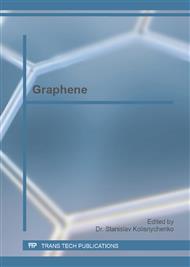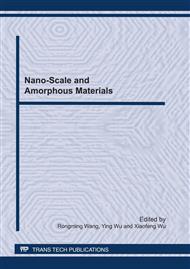[1]
S. Iijima: Nature Vol. 354 (1991), p.56.
Google Scholar
[2]
C.M. Niu, E.K. Sichel, R. Hoch, D. Moy and H. Tennent: Appl. Phys. Lett. Vol. 70 (1997), p.1480.
Google Scholar
[3]
R.Z. Ma, J. Liang, B.Q. Wei, B. Zhang, C.L. Xu and D.H. Wu: J. Power Sources Vol. 84 (1999), p.126.
Google Scholar
[4]
J.H. Chen, W.Z. Li, D.Z. Wang, S.X. Yang, J.G. Wen and Z.F. Ren: Carbon Vol. 40 (2002), p.1193.
Google Scholar
[5]
E. Frackowiak and F. Béguin: Carbon Vol. 40 (2002), p.1775.
Google Scholar
[6]
C.S. Du, J. Yeh and N. Pan: Nanotechnology Vol. 16 (2005), p.350.
Google Scholar
[7]
Q. Jiang, Y. Zhao, X.Y. Lu, X.T. Zhu, G.Q. Yang, L.J. Song, Y.D. Cai, X.M. Ren and L. Qian: Chem. Phys. Lett. Vol. 410 (2005), p.307.
Google Scholar
[8]
Z.J. Li, L. Wang, Y.J. Su, P. Liu and Y.F. Zhang: Nano-Micro Lett. Vol. 1 (2009), p.9.
Google Scholar
[9]
C. Arbizzani, M. Mastragostino and F. Soavi: J. Power Sources Vol. 100 (2001), p.164.
Google Scholar
[10]
Y.D. Zhu, H.Q. Hu, W.C. Li and X.Y. Zhang: Carbon Vol. 45 (2007), p.160.
Google Scholar
[11]
X.Y. Han, Y.H. Gao and X.H. Zhang: Nano-Micro Lett. Vol. 1 (2009), p.4.
Google Scholar
[12]
L. Jin, C. Bower and O. Zhou: Appl. Phys. Lett. Vol. 73 (1998), p.1197.
Google Scholar
[13]
M. Hughes, M.S.P. Shaffer, A.C. Renouf, C. Singh, G.Z. Chen, D.J. Fray and A.H. Windle: Adv. Mater. Vol. 14 (2002), p.382.
Google Scholar
[14]
Q.L. Chen, K.H. Xue, W. Shen, F.F. Tao, S.Y. Yin and W. Xu: Electrochim. Acta Vol. 49 (2004), p.4157.
Google Scholar
[15]
J.S. Ye, H.F. Cui, X. Liu, T.M. Lim, W.D. Zhang and F.S. Sheu: Small Vol. 1 (2005), p.560.
Google Scholar
[16]
J.M. Soon and K.P. Loh: Electrochem. Solid-State Lett. Vol. 10 (2007), p. A250.
Google Scholar
[17]
W.C. Fang, O. Chyan, C.L. Sun, C.T. Wu, C.P. Chen, K.H. Chen, L.C. Chen and J.H. Huang: Electrochem. Commun. Vol. 9 (2007), p.239.
Google Scholar
[18]
H. Zhang, G.P. Cao, Z.Y. Wang, Y.S. Yang, Z.J. Shi and Z.N. Gu: Nano Lett. Vol. 8 (2008), p.2664.
Google Scholar
[19]
K.W. Nam, C.W. Lee, X.Q. Yang, B.W. Cho, W.S. Yoon and K.B. Kim: J. Power Sources Vol. 188 (2009), p.323.
Google Scholar
[20]
W.D. Zhang and J. Chen: Pure Appl. Chem., Vol. 81 (2009), p.2317.
Google Scholar
[21]
Z. Fan, J.H. Chen, B. Zhang, B. Liu, X.X. Zhong and Y.F. Kuang: Diam. Relat. Mater. Vol. 17 (2008), p. (1943).
Google Scholar
[22]
S. Wei, W.P. Kang, J.L. Davidson and J.H. Huang: Diam. Relat. Mater. Vol. 17 (2008), p.906.
Google Scholar
[23]
Y.H. Wang, H. Liu, X.L. Sun and I. Zhitomirskya: Scripta Mater. Vol. 61 (2009), p.1079.
Google Scholar
[24]
Y.T. Jang, J.H. Ahn, Y.H. Lee and B.K. Ju: Chem. Phys. Lett. Vol. 372 (2003), p.745.
Google Scholar
[25]
S. Wei, W.P. Kang, J.L. Davidson and J.H. Huang: Diamond Relat. Mater. Vol. 15 (2006), p.1828.
Google Scholar
[26]
X.B. Zhang, K.L. Jiang, C. Feng, P. Liu, L.N. Zhang, J. Kong, T.H. Zhang, Q.Q. Li and S.S. Fan: Adv. Mater. Vol. 18 (2006), p.1505.
Google Scholar
[27]
K. Liu, Y.H. Sun, L. Chen, C. Feng, X.F. Feng, K.L. Jiang, Y.G. Zhao and S.S. Fan: Nano Lett. Vol. 8 (2008), p.700.
Google Scholar
[28]
J. Li, Q.M. Yang and I. Zhitomirskya: J. Power Sources Vol. 185 (2008), p.1569.
Google Scholar
[29]
D.D. Zhao, Z. Yang, E.S.W. Kong, C.L. Xu and Y.F. Zhang: J. Solid State Electr. (2010), DOI: 10. 1007/s10008-010-1182-x.
Google Scholar
[30]
D.D. Zhao, Z. Yang, L.Y. Zhang, X.L. Feng and Y.F. Zhang: submitted to Mater. Chem. Phys. (2010).
Google Scholar



